The developer provided Play Critically with a review code for this videogame.
Blitz Smash Ultimate is a top-down shooter that places me and up to three local co-op players in the role of a hero with a gun who shoots an overwhelming number of extradimensional enemies on a rescue mission in an endless, neon void. I play as Zealot, a girl living in a world where gates leading to new and unusual spaces are commonplace. Together with her brother, Solitude, Zealot goes through the gates to explore the Other Dimension, a neon world of simple geography abundant with valuable crystals, Red Eye Orbs, and coveted Blitz Weapons. Basing themselves in a village where a new gate has been discovered, when Zealot and Solitude enter the Other Dimension, the sister arrives on the other side to find herself unexpectedly alone. Armed with a modular machine gun, Zealot must shoot her way through eight layers of the Other Dimension filled with hostile alien lifeforms to reunite with her brother.
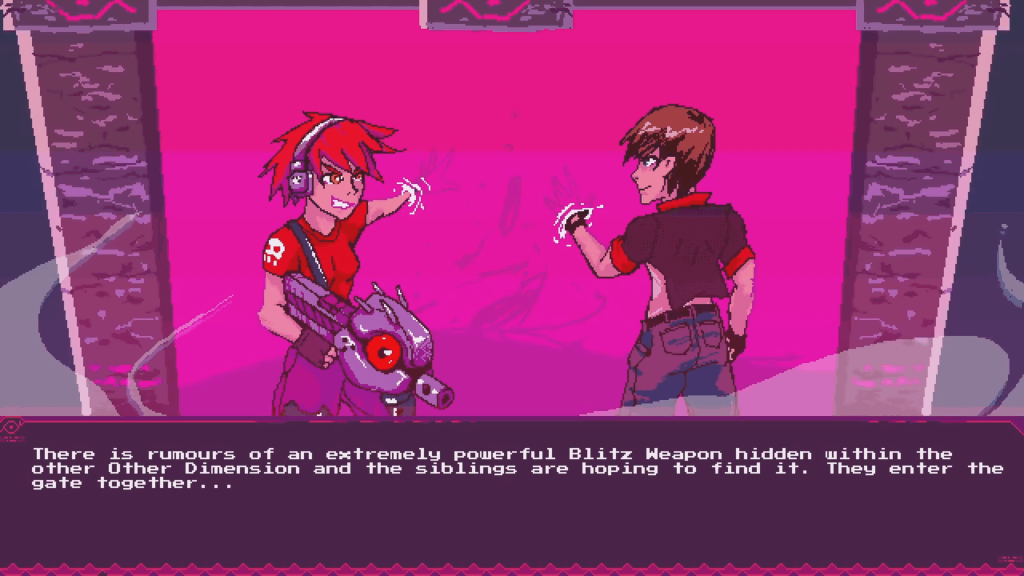
Looking at Blitz Smash Ultimate in screenshots and video, I presume it is a twin-stick shooter, a videogame played from a top-down perspective where the player character’s movement is steered with one controller input and the direction they point their firearm aimed with another. Once I have control of Zealot, I am surprised to discover that the control scheme is both simpler and more complicated than this traditional setup. Zealot will always fire in the direction she is facing, but once she begins, she will continue firing in that direction until I release the button regardless of where I steer her afterwards. This peculiar design has a pronounced effect on Blitz Smash Ultimate’s shooting. It emphasizes spray-and-pray and strafing tactics instead of precision aiming, ensuring Zealot pumps out thousands of bullets in the time it takes her to reunite with her brother while she weaves through the Other Dimension’s winding, checkerboard corridors.
When Zealot first enters the Other Dimension from her village base, her gun is functional, but plain. It never needs to be reloaded, so it can endlessly fire a staccato stream of projectiles. Its firing pattern may be modified by powerups that drop from destroyed enemies, chests, and environmental objects. Collecting powerups feels finicky at first. I have to press the gamepad’s confirm button when Zealot is near a pickup before she will collect it. When the area is littered with up to a dozen pickups from the currencies that also drop from enemies and the environment, the amount of button-pressing to gather them all feels excessive. A particular feature of the gun powerups justifies this odd choice.
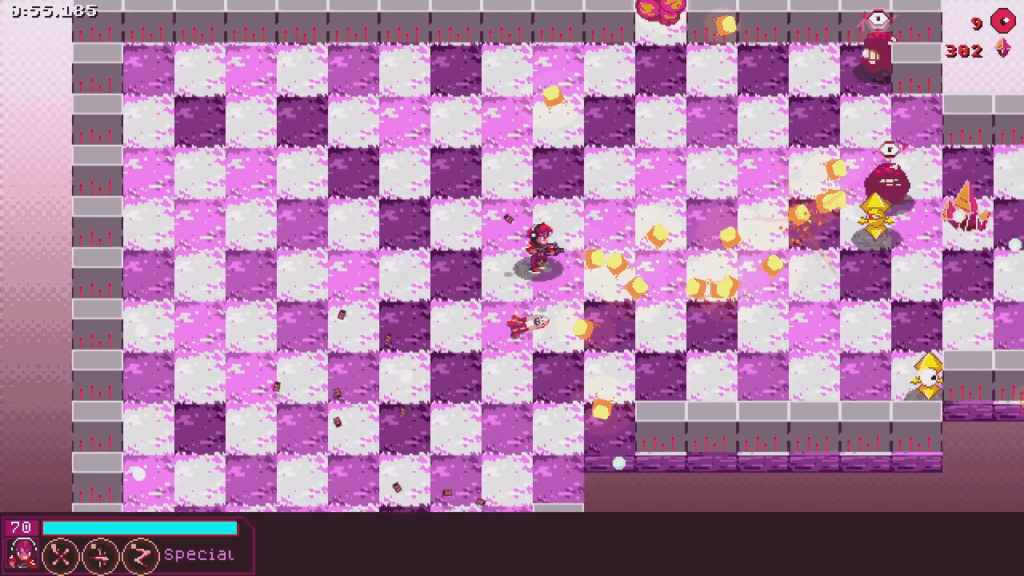
Each powerup’s function is displayed as a graphic whose meaning takes some time and experimentation to learn. A powerup marked with three arcing lines causes Zealot’s gunfire to split into three streams. One marked with an X makes projectiles burst in an X-shape when they strike enemies. A wavy line icon causes projectiles to arc towards nearby enemies. Up to three powerups may be collected at once and their effects stack. It’s interesting to experiment with different combinations to see how effective the results can be, though all of them tend to result in greater killing power than the default gun. It’s difficult to make a poor choice, instead becoming a matter of finding a combination that is most right. This is why it’s important that gathering a powerup be a purposeful, button-driven action: It prevents Zealot from overwriting an advantageous combination by stepping too near a new pickup.
When Zealot’s gun is loaded with three powerups, she may activate its final feature. Consuming all three powerups sends the gun into overdrive, firing at a faster rate and for greater damage for a short period of time. This never feels worth it. Once the effect ends, Zealot’s gun returns to its default state and she must collect randomly dropped powerups to return it to a more effective one. It always feels wiser to find a strong combination of powerups and stick with them for the duration of Zealot’s time in the Other Dimension, even at the cost of ignoring one of her most potent abilities.
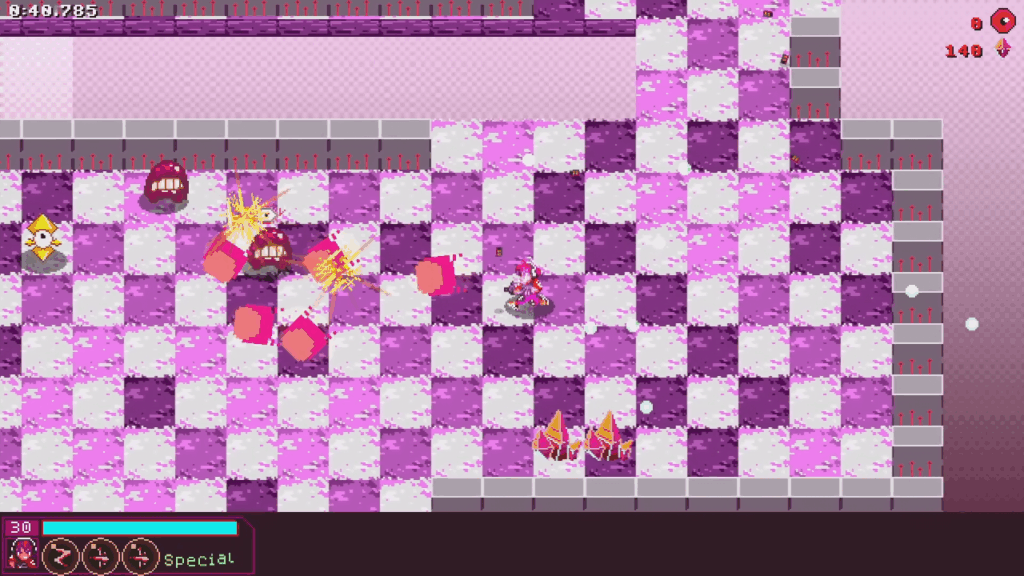
Zealot has a second offensive option but it is difficult to recognize it as such. Another gamepad face button prompts Zealot to dash forward in the direction she is already moving. This dash not only moves her quickly forward and may be used repeatedly with no discernible cooldown, it also damages enemies when it contacts them and reflects oncoming projectiles. There is no visual feedback that this dash does anything other than move Zealot from one place to another. It takes about a half-dozen dashes into an enemy to destroy them before I accept that the loading screen tips aren’t lying to me. I end up treating the dash like what it appears to be: A quick movement option and nothing more. I must still keep these dash functions in the back of my mind while playing as several unique enemy types and boss encounters utilize them.
Zealot encounters a melange of unusual lifeforms while exploring the Other Dimension. Early on, she faces cycloptic drones whose basic functionality is a mirror of Zealot’s own, only with greatly reduced aggression and firepower. They are not threatening. As she progresses through the Other Dimension’s layers, enemies become more fantastic. Ghosts haunt the second layer and swarming jellyfish, or something like them, have made the third layer their home. Near the bottommost layer, Zealot encounters the most alien lifeforms encased in crystal armor.
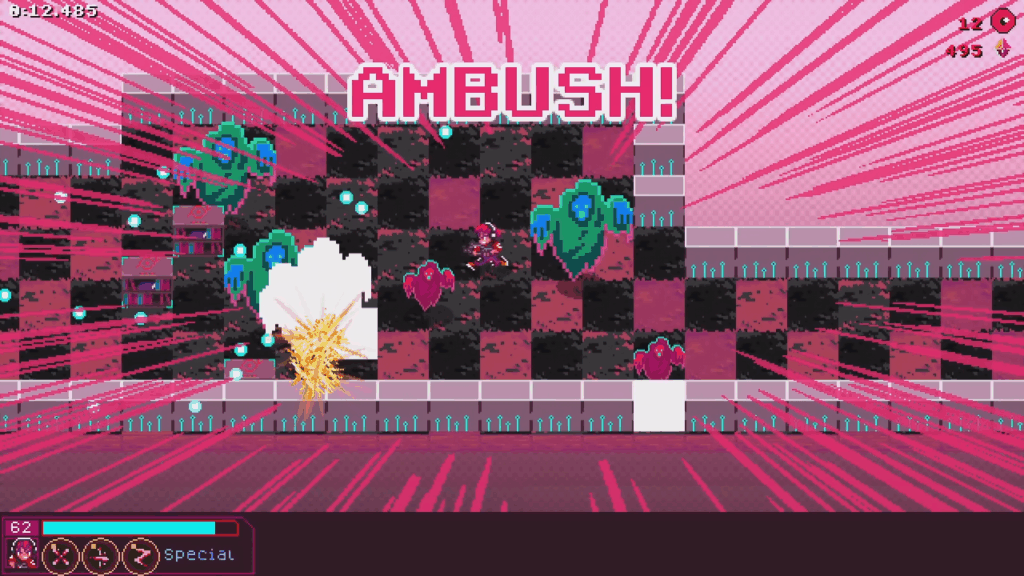
I am impressed by how much each new enemy type changes up the approach Zealot must take to succeed. The earliest drone enemies allow the most conventional response. After a few floors have ingrained a careless and sloppy approach to gunning, this approach is harshly countered by ghosts. These enemies take far more punishment than drones and will pursue Zealot much faster than she can flee while firing her weapon. At first this behavior is vexing until I notice that ghosts are docile until struck, teaching me to have Zealot step lightly and shoot carefully in their region. The next enemy set once again deliberately upsets a now-familiar dynamic. The third layer’s jellyfish enemies are felled by just a few rounds of gunfire but attack in huge swarms, demanding the exact opposite approach from ghosts: Indiscriminate, desperate gunfire. Every time Zealot makes a notable step forward in the Other Dimension, she meets a new set of enemies that requires a whole new strategy to effectively overcome.
In marked contrast to the enemy variety, Blitz Smash Ultimate’s level design is far less engaging. Though the different types of enemies create a definite sense of passing through multiple regions, the geography of these settings does not communicate the same idea.
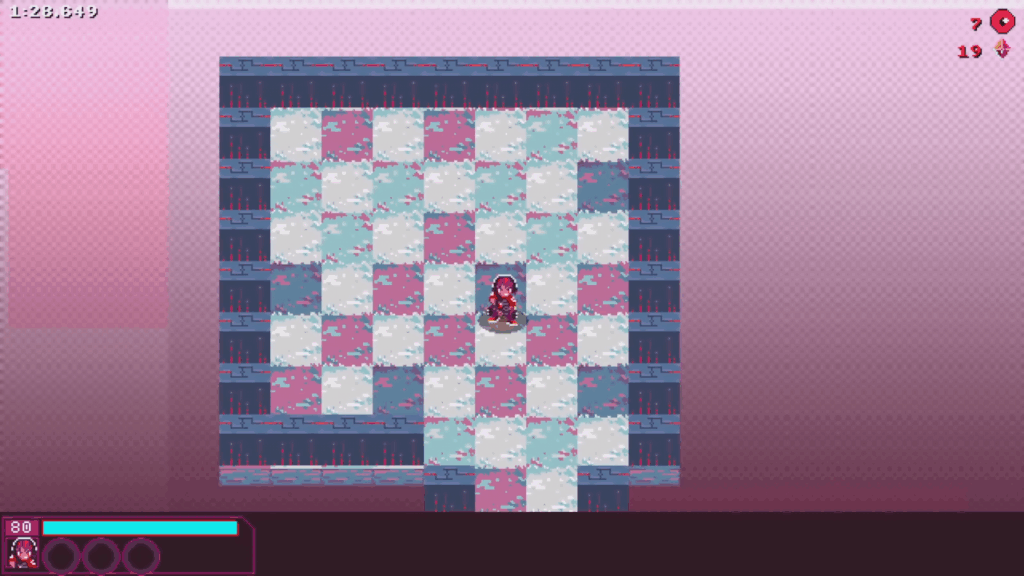
Everywhere Zealot travels in the Other Dimension is portrayed as a broad platform suspended high above a featureless field. It winds randomly along a linear path until it ends on a portal leading to the next floor. If Zealot steps off this platform, or is knocked off by an enemy attack or an explosion from the mines scattered around some floors, she is instantly transported back to the village base and must try again from the beginning. A barrier fences the player character onto this suspended platform, but it can and probably will be broken by gunfire as Zealot shoots down the enemies in her way. I must always make sure I am steering her carefully as any misstep can lose all of her current progress.
An effort is made to differentiate spaces by giving them some distinct features, such as broader or narrower passages in some floors. Some passages are so narrow that Zealot can only pass through by destroying the perimeter barriers that are meant to protect her. The effect this has on placing Zealot in a distinct place is minimal. Stripped of their unique enemies, every floor in the Other Dimension looks and feels mostly the same.
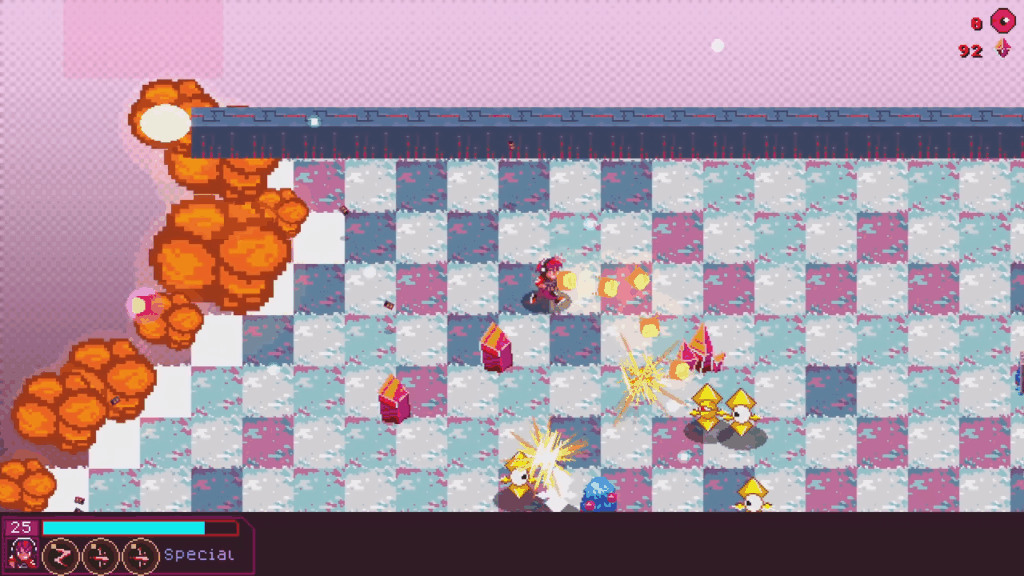
A second factor I must be aware of in levels is time. Most floors in the Other Dimension are governed by a time limit. When it expires, the checkerboard floor begins to explode, one row at a time, beginning from the floor’s origin and extending all the way to its terminus. If the explosion reaches Zealot, it will bring her run to a premature end. This is especially hazardous early in a run when Zealot is at her weakest. After passing through a half-dozen floors it stops being an issue. Zealot can blast through the thickest of enemy clusters much faster than the clock can tick down.
While collecting powerups for Zealot’s gun is an effective way to give her weapon more oomph, the main method for making her more powerful is to finish floors. When Zealot reaches a teleportal leading to the Other Dimension’s next floor, she is prompted to select from three upgrades randomly chosen from a larger pool. Upgrades persist for the remainder of Zealot’s current visit to the Other Dimension and provide new effects, like adding a small chance for her projectiles to deal critical damage or emit a missile every few shots. The most effective upgrades are the mundane ones that provide a flat increase to Zealot’s projectile and dash damage. Stacking as many of these as possible is essential for surviving in the Other Dimension’s deepest levels and against its toughest foes.
These toughest foes include the Other Dimension’s bosses. Zealot faces one of these titanic challenges every three floors and defeating each one represents a transition into a new area filled with new enemies.
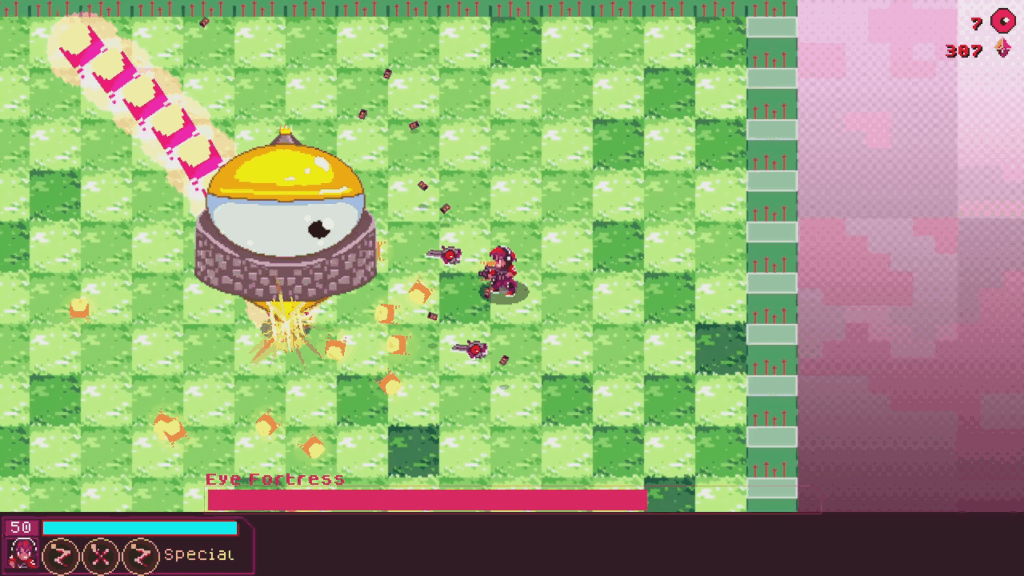
Boss designs once again make me recall twin-stick shooting designs. They come in a variety of shapes. A giant armored eye rests motionless at the center of its battlefield, twisting and pivoting in place to fix its gaze on Zealot and fire its defenses at her. A massive ghost teleports across the screen, requiring frequent adjustment of Zealot’s aim. A behemoth crystal, either a single entity or a ship containing numerous tiny ones, strafes along a narrow strip of land, trying to buffet Zealot off its edge. All of these creatures share common design elements that grow in intensity and complexity over time, either blasting Zealot with fast-moving projectiles she must weave skillfully between or emitting infrequent and slow-moving blasts she must avoid with careful navigation and precise timing. The best bosses combine both elements.
Whenever Zealot runs out of hit points or falls off of the world in the Other Dimension, she is sucked back to her homeworld village base with any valuables she collected still in her pockets. Vendors with familiar faces sitting around the village screen will exchange these riches for new upgrades.
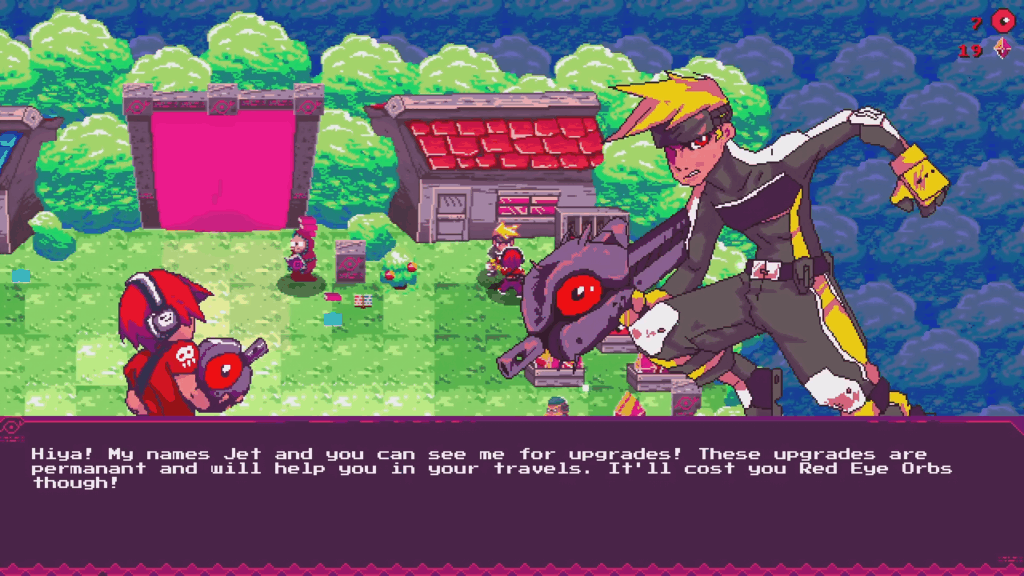
A pet shop owner wearing a cuddly bear head adds helpful animal and robot companions to the pool of upgrades Zealot may choose at the end of each level. A red-haired miner opens portals to every floor of the Other Dimension that Zealot has set foot upon, functioning almost as a checkpoint—though taking a shortcut precludes collecting end-of-level upgrades, so it is rarely worth attempting. A ninja youth is the most important vendor. He sells upgrades that improve Zealot’s statistics across all future visits to the Other Dimension, including game changing effects like additional health and an extra life.
The trouble is in how the currencies that pay for these upgrades are distributed. The valuables Zealot collects in the Other Dimension are crystals and Red Eye Orbs. There are far fewer upgrades to purchase with crystals than with Red Eye Orbs, but crystals drop in far greater numbers. Even at the deepest levels of the Other Dimension, where Red Eye Orbs are at their most plentiful, Zealot will find hundreds of crystals before finding a single Red Eye Orb.
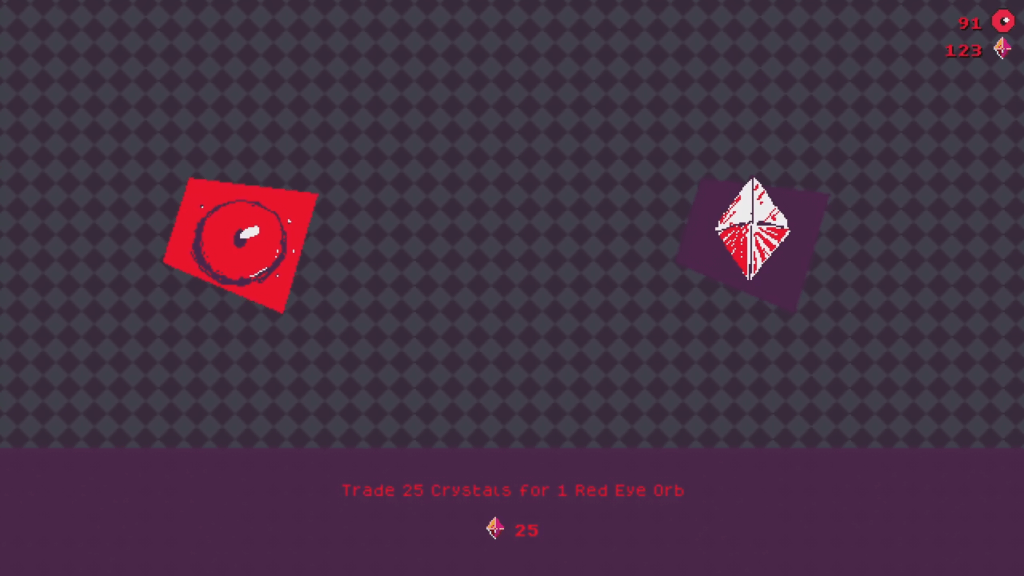
This would seem to be a broken economy, except for another vendor in the village who exchanges both currencies for their counterpart at an equal exchange rate. This is a silly addition. It makes crystals and Red Eye Orbs interchangeable in function and value. All the separation really adds is the necessity to speak with another vendor before making a purchase. It’s a minor speedbump that makes me laugh more than it annoys me but is still notable.
This economy is central to another problem with Blitz Smash Ultimate’s design. The longer I play, the less incentive there is for me to engage with most of its systems. It is simple to run through most of the Other Dimension’s levels without shooting anything. Against some enemy varieties, this is even preferable. Obstacles that prevent Zealot’s forward progress are rare and are easily overcome without worrying about enemy retaliation. There is no disincentive for doing so; Zealot earns end-of-level upgrades regardless of how many extradimensional aliens she shoots before entering the portal. The only real imperative to shoot at enemies is to earn crystals and Red Eye Orbs. The more upgrades Zealot purchases, the less this imperative is felt. By the time Zealot has bought the entire village’s stock, the optimal way to play Blitz Smash Ultimate is to run from the beginning of the first level all the way through the last without firing a shot outside boss encounters. The more I play Blitz Smash Ultimate, the less interesting it becomes. Not even an optional, post-game Boss Rush with a bonus boss lurking at its end does much to re-engage me.
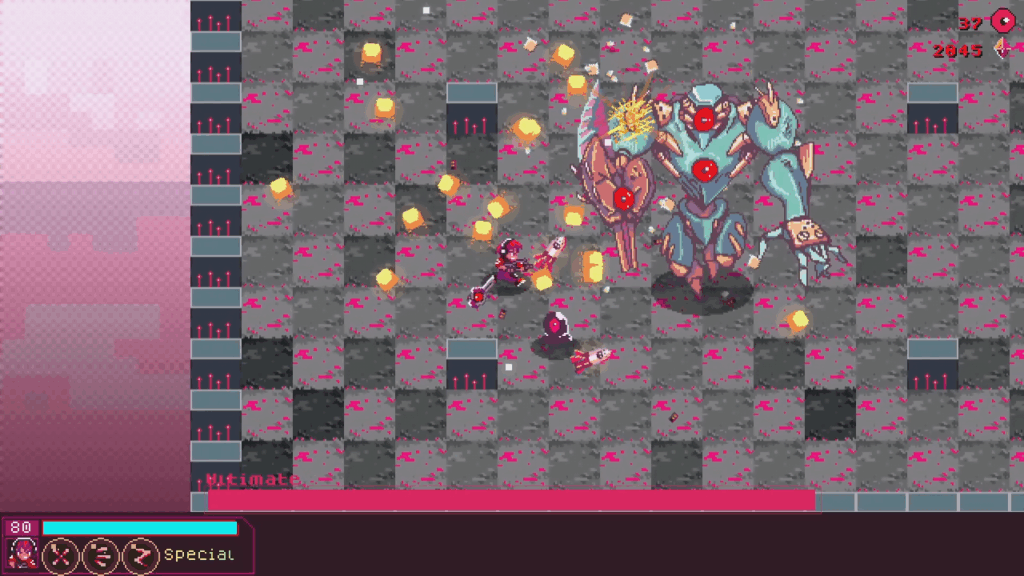
Blitz Smash Ultimate is an adequate top-down shooter that is eventually undermined by some fundamental design flaws. It nails its retro aesthetic, adorning the Other Dimension’s surfaces in sickly, candy-colored neon and bombarding my ears with a high-tempo chiptune track. While at first I am confused by a lack of twin-stick controls in a presentation that borrows from twin-stick conventions, I adjust quickly. I enjoy discovering the best combinations for upgrading Zealot’s gun and how to deal with the array of different enemies she encounters. It’s in its economy where Blitz Smash Ultimate begins to break down. There are no compelling choices to make between crystals and Red Eye Orbs since the two currencies are made interchangeable by a pivotal NPC. Once I’ve purchased every upgrade, there is no incentive to do anything in the Other Dimension except run to the next boss. I am entertained and charmed by Blitz Smash Ultimate in my first few hours with it. That’s all I expect from a videogame, especially from a low-budget indie like this. With a few tweaks to some of its systems, I might enjoy it for much longer.